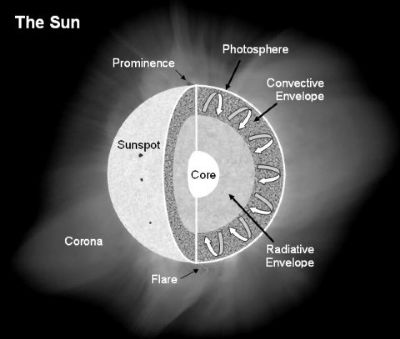Seeing Stars – Inverness Courier, Friday 3rd June, 2005
Here Comes the Sun
By Andy Ferguson
4,600 million years ago a huge, cold cloud of hydrogen gas, mixed with minute dust particles from old supernova explosions, received a wake up call. A passing star, or perhaps another nearby stellar explosion, caused a shock wave to pass through this cloud and as a result, it began to compress. Gravity took over and the cloud began to spin and flatten into a disk. As the gas moved towards the centre of the disk, the rocky particles began to collide, stick together and accumulate into planets. The remnants of gas in the extremities of the disk formed into giant gas planets.
Meanwhile, the gas at the centre of the disk had compressed into a huge spinning sphere. Enormous pressure and temperature built up in the centre of the sphere and eventually reached a point where thermonuclear fusion reactions were triggered, converting hydrogen into helium and releasing vast quantities of energy and light in the process. The resulting initial blast blew away the remaining gas and small particles in the disc – The Sun and Solar System had been born.
The Sun, actually a star with, as far as stars go, a modest diameter of 1.4 four million kilometres, is the dominant direct energy input into the terrestrial ecosystem. It affects all physical, chemical and biological processes on Earth. It takes a million years for the heat produced in the core to work its way to the surface but only 8.3 minutes to reach us. As a result of the nuclear fusion, the Sun is losing about 5 million tons of mass per second. Don’t worry; there is enough of it to last another 5 billion years or so.
From an estimated 20 million degrees at the core the temperature drops to 4 million degrees in the convection zone, where convective cells carry the heat to the surface, or photosphere. This is the part of the Sun we normally see and is a relatively cool 5,800 degrees. Despite the massive size of the Sun, the photosphere is only a few hundred kilometres thick and the surface is covered by the tops of the convective cells, which are called granules, giving the surface a mottled appearance.

Sunspots are darker, cooler areas of the photosphere where the magnetic fields of the convective cells block heat from getting to the surface. They lie slightly below the surface. This is most visible when the sunspots are near the limb and is called the Wilson Effect, after Scottish astronomer Alexander Wilson who first observed it. Around the dark sunspot is the slightly lighter, and frilly, penumbra. Above the photosphere is the Sun’s atmosphere or Corona. This cloud of charged particles is a million degrees C and only visible with specialised equipment, or during the brief moments of a total solar eclipse.
Expensive hydrogen-alpha filters show bright luminous hydrogen clouds, called faculae, above areas where sunspots are about to form. Due to the magnetic disturbances around sunspots, flares, or filaments, can often be seen emanating from them. Occasionally, magnetic reconnection takes place and a huge explosion of plasma, called a coronal mass ejection, or CME, takes place. Billions of tons of charged particles are hurled into space, sometimes towards Earth, where they give us the ethereal Aurora Borealis, damage satellites, interfere with radio and television and even overload power grids. Astronauts have to shelter in screened compartments on the International Space Station to avoid radiation poisoning from gamma rays. Fortunately Earth’s magnetic field protects us from real harm. H-alpha filters also show huge prominences, many times the size of Earth and jutting from the surface into the Corona, as huge loops of fire arcing off the surface and crashing back down thousands of miles away.
Our Sun is a giant dynamo that produces a huge magnetic field which is largely responsible for the phenomena we can see and for blasting out particles throughout the Solar System. Far from being a quiet, stable star, the Sun goes through an 11 year cycle, producing large crops of sunspots at its peak and reversing its magnetic field before taking a rest for a few years. It is currently slipping into its quiet phase.
Despite being our nearest star, the Sun still holds many mysteries we have so far been unable to solve. Current space missions, like Soho, Trace and Ulysses, continue to investigate, photograph and monitor it, to try and improve our current level of knowledge.
WARNING! viewing the Sun can be highly dangerous!! Even looking at it with the naked eye can damage your eyesight. Using unfiltered binoculars or telescopes will permanently damage eyesight or cause blindness in a fraction of a second. Specialised filters are the only safe way to observe with these instruments. Inexpensive ‘White light’ filters can be used to view sunspots and granulation but the safest way to observe is by ‘eyepiece projection’ onto a white card. A telescope or one ‘leg’ of a binocular (blank off the unused one at the front) is aimed at the Sun and an image projected from the eyepiece onto a white card, or similar. To increase image visibility you can put a guard made of cardboard around the instrument to block off extraneous light.